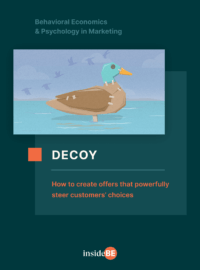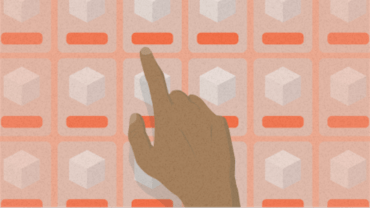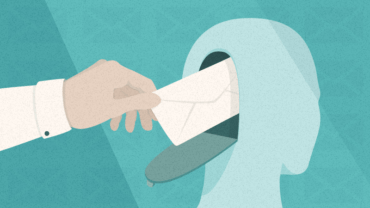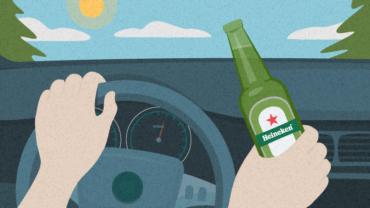Case Study: How Curaprox Can Use the Decoy Effect to Sell More Expensive Toothbrushes
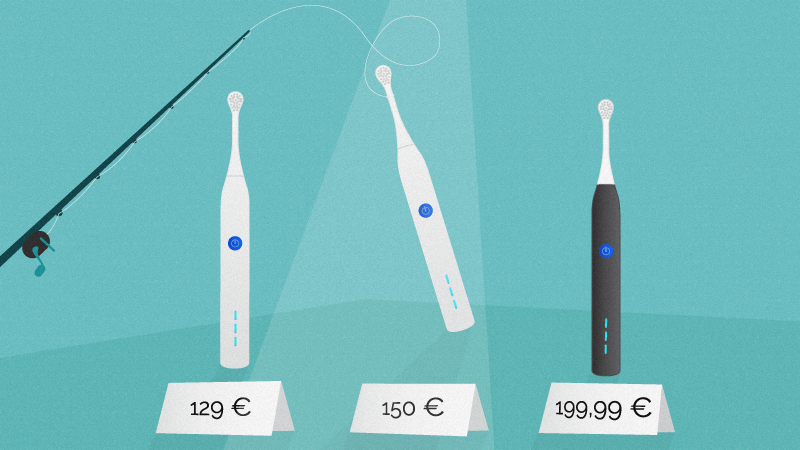
In this case study, you’ll discover:
- What the Decoy Effect is and why it can help;
- What isn’t working in Curaprox’s current product selection;
- What mistake Curaprox makes on product pages but not on pamphlets; and
- What grievances customers feel even when they chose the priciest toothbrush.
What’s a decoy?
We’ve actually written a whole article on the Decoy Effect – in case you want to get an overview, we recommend starting with that article first.
In short, the Decoy Effect is a pricing strategy that businesses use to get us to switch from one option to the one that’s more expensive and profitable for them.
Decoy Effect
Decoy is an option which no one is interested in because it’s objectively inferior to other options. It isn’t designed to be sold. Decoy has a different objective – to make other options seem more attractive.
It occurs when our preference for one of two options changes dramatically when a third similar but less attractive option is added.
A decoy is not meant to sell, but just because it’s there it changes how we evaluate the two original options. It makes choosing easier because it leads us to conclude that one of the options is the superior one. In fact, there’s evidence that a well-designed decoy can shift preference between the other two options by as much as 40%.
Choose a good decoy and people won’t even realize they’re being influenced. Instead, they’ll feel as if they’re making a logical choice for themselves.
Choose a good decoy and people won’t even realize they’re being influenced. Instead, they’ll feel as if they’re making a logical choice for themselves.
The “basic” decoy
The most straightforward use of the Decoy Effect is to offer less of the same for almost the same price. That’s why you’ll find that prices of medium-size products – anything from smoothies, popcorn, coffee, perfumes – are just outrageous compared to the large ones.
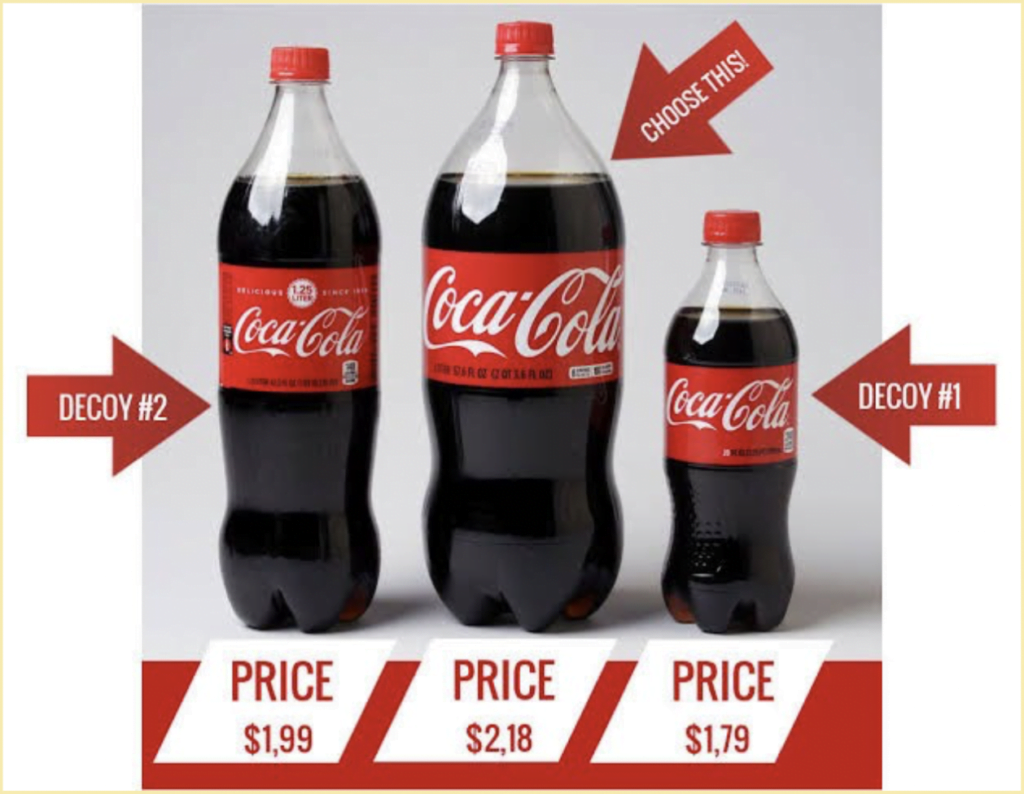
Source: Drvidya Hattangadi
It’s no accident. When you see 0.5l of soda priced at $1.79, 1l for $1.99, and 2l for $2.18, then you know you’ve come across a decoy. If you do all the computation in your head, you’ll see that the medium-size option is a better deal than the small one, while the large-size one is an even better deal.
If you’re trying to resist decoys, the good news is these are easiest to spot. But then there’s the sneaky one…

Discover ground-breaking ideas and fascinating solutions.
The sneaky decoy
The pro way is to go the Apple way. They don’t push customers toward the most expensive option. Instead they leverage a pricing strategy that involves three options: one that’s too high for most, one that’s too low for most, and one that’s just right (also known as the Goldilocks Effect).
Apple relies on not just one, but 2 decoys. See if you can spot them in the pricing of its iPod Touch from way back when:
- 16GB for $229 – without 5MP iSight camera and iPod Touch Loop
- 32GB for $299 – with 5MP iSight camera and iPod Touch Loop
- 64GB for $399 – with 5MP iSight camera and iPod Touch Loop
It’s clear that with each upgrade there’s a series of trade offs to make. But thanks to decoys, these trade-offs are not valued in the same way.
An upgrade from 16 to 32GB, which costs an additional $70, feels like a sensible decision – you get double the storage capacity and also get more features – while the other upgrade (from 32GB to 64GB) only doubles the storage capacity and costs $100. The decision almost feels like a no brainer – 32GB iPod offers the best value for money.
Both 16GB and the 64GB versions are designed to make the target – a fancy word for a product that the business really wants to sell (which in this case is the 32GB iPod) more appealing. Apple also uses this strategy for higher-priced products, such as the MacBook Pro.
3 brushes + 0 decoys = a 100% chance of becoming overwhelmed
Curaprox. Let’s start off by saying we love the brand. In fact, this article was inspired by the author’s own experience when she was deciding which of its 3 hydrosonic brushes to buy.
It took her way longer than it should have and required bucketloads of sheer determination to make a decision and not back down from it. Buying a brush should never be this difficult! She even caught herself thinking: Oh boy, where is a decoy to make this easier!
Let’s start with a play-by-play of all the things that made choosing the right brush so incredibly hard, and then finish off with 2 strategies Curaprox could use to leverage the power of the Decoy Effect.
The problem
Imagine you want to replace your old manual brush with a breath of fresh air – the hydrosonic brush. But when looking at the three options on the Curaprox page, you’re none the wiser!
It turns out all the bells and whistles of each brush are hard to compare. In fact, the whole system is designed in such a way that it doesn’t allow for easy comparison.
There are 3 crucial mistakes that lead customers to feel overwhelmed:
Mistake number 1. A single page overview is missing
3 different types of brushes give a great foundation for employing the decoy effect.
So without further ado, let’s greet our three contestants to the ring:
- Lightweight – the most basic and cheapest brush called “Easy” is priced at $129;
- Midweight – has a fancier name “Black is white“ and is priced at $150;
- Heavyweight – the most expensive “Pro” brush comes at a whopping $199.99 (based on the price alone, we assume it could be the target – the one Curaprox aims to push forward).
However when you arrive on the product landing page, you don’t see 3 brushes, just 2.
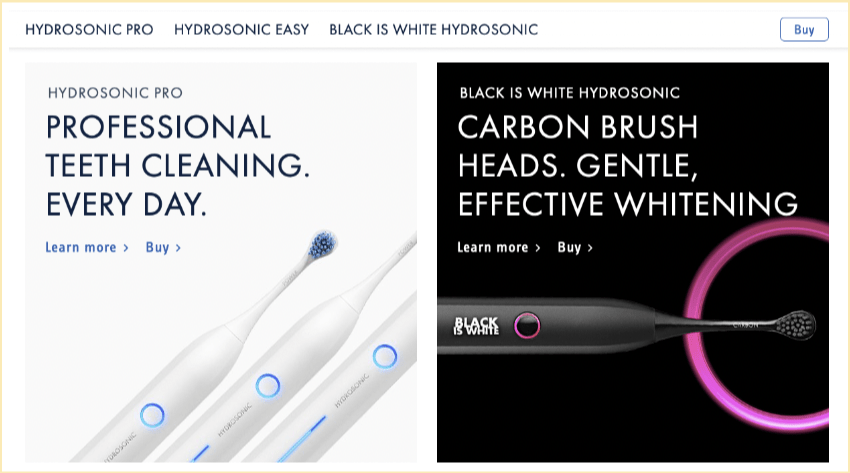
Source: Curaprox
And it gets worse. There’s not a single, easily digestible, one-page overview of all the brushes and their key product features anywhere on the page. If you want to see the other two brushes, you have to toggle back and forth between pages.
This creates complexity and makes it harder to understand, not to mention, harder to register all the available benefits. Having to seek out three different web pages forces customers to work harder, even when all they really want is to make a quick, simple, and intuitive decision.
The copy doesn’t help either. Do I want professional or gentle effective whitening? And what if I want both? It’s not clear which brush is the more superior option – the target – and none of them feels like a decoy. They’re just two incomparable options.
Mistake number 2. The pages highlight different parameters for different brushes
Like we said, Easy is not even on the front page. So to learn about its bells and whistles, one needs to locate it on the navigation bar. Here it’s not exactly clear why it appears in the center – as that is usually the most prominent space.

Source: Curaprox
Now compare the features of Easy with the features of Pro.

Source: Curaprox
Even though 3 out of 4 parameters (cleaning levels, battery life, brush heads) are comparable, the way they are presented doesn’t give the visitor an instant sense of the main commonalities and differences.
As a result, this creates even more questions. It’s clear that Easy doesn’t come with a single head (it’s that fancy little brush that gets into every nook and cranny). You might think to yourself: “But if I bought it extra, it would fit on the Easy brush too, right?”
The answer is “you don’t know” and it takes quite a bit of digging around the page to find the sweet reassurance that “Every Curaprox brush head fits every Hydrosonic toothbrush”.
Mistake number 3. The offer has no obvious, superior option
So far the whole experience is quite confusing – maybe a third option will be easier to compare.

Source: Curaprox
No luck. The Black is White brush is framed as “super styled”, bringing up even more complexity and a bunch of mixed feelings.
How about those brush movements per minute? What does it mean? What if I have sensitive gums – 84,000 movements seems like a lot. How many does the Pro have?
Also, you might wonder why the Black is White brush only has 3 cleaning levels (the same number as the more “basic” Easy brush). Will it be enough? The Pro brush has 7 – it seems like a large gap.
But on the other hand, the Black brush has those fancy-schmancy whitening heads. So will it do? It should, shouldn’t it? Is the Pro brush overkill or is it really worth the extra 50 dollars?
Unless you’re only deciding based on color – and you love black – you’re left feeling like whatever way you choose, you still won’t be 100% satisfied – that is, if you were even able to store all that information in your head after toggling between the pages…
The Solution:
Put the brushes on one page and unify the parameters so customers can see clearly what’s the same and what they get on top of each price increase – which, to be fair, is what Curaprox does quite well in their pamphlet.
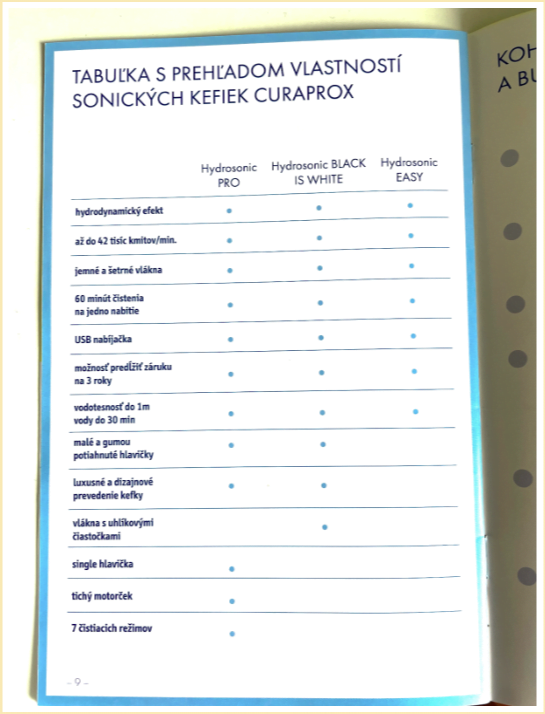
Source: Author’s archive
But right now there’s no sense of a decoy. Even people who choose to buy the Pro – the priciest brush – might still feel like they’re missing out on the gentle whitening, which is a bummer. With the most pro option, the customer should never be left to wonder whether they got it all.
Let’s now look at some creative ways to leverage the Decoy Effect in Curaprox pricing and product selection.
Designing a decoy could look differently depending on which brush is your target:
Option 1. Introduce 2 decoys
Curaprox could get inspired by Apple and make the middle priced brush the target – with the most expensive and the least expensive options as decoys.
In this case, the product selection could look like this:
We mark the updated features of each option in relation to its “inferior” option in bold.
Decoy 1: Hydrosonic Easy for $129
- Colors: white
- Cleansing levels: 3
- Movements per minute: 44,000
- Battery life: more than 60 minutes of brushing from one USB charge
- Brushes: Sensitive, Power brush head
- No travel package
The target: Black is White Hydrosonic for $170.
- Colors: white/black
- Cleansing levels: 7
- Movements per minute: 84,000
- Battery life: more than 90 minutes of brushing from one USB charge
- Brushes: Sensitive, Power, and Carbon brush heads (available in both black or white so there is no color mismatch with the body of the brush).
- Travel package
If you make the switch from the Hydrosonic Easy brush to the target for an additional 40 dollars, you’ll get an upgrade in all the core features: cleansing levels, movements per minute, brushes, and battery life + you would even get a holiday travel package for good measure.
Decoy 2: Hydrosonic Pro for $219.99
- Colors: white, black, white/black with Rose Gold, Gold, or Silver rim around the button
- Cleansing levels: 7
- Movements per minute: 84,000
- Battery life: more than 120 minutes brushing from one USB charge (currently all the brushes have 60 minutes)
- Brushes: Power, Sensitive, Single, and Carbon brush heads (available in both black or white so there’s no color mismatch with the body of the brush). Premium travel package (plush with silver/gold elements)
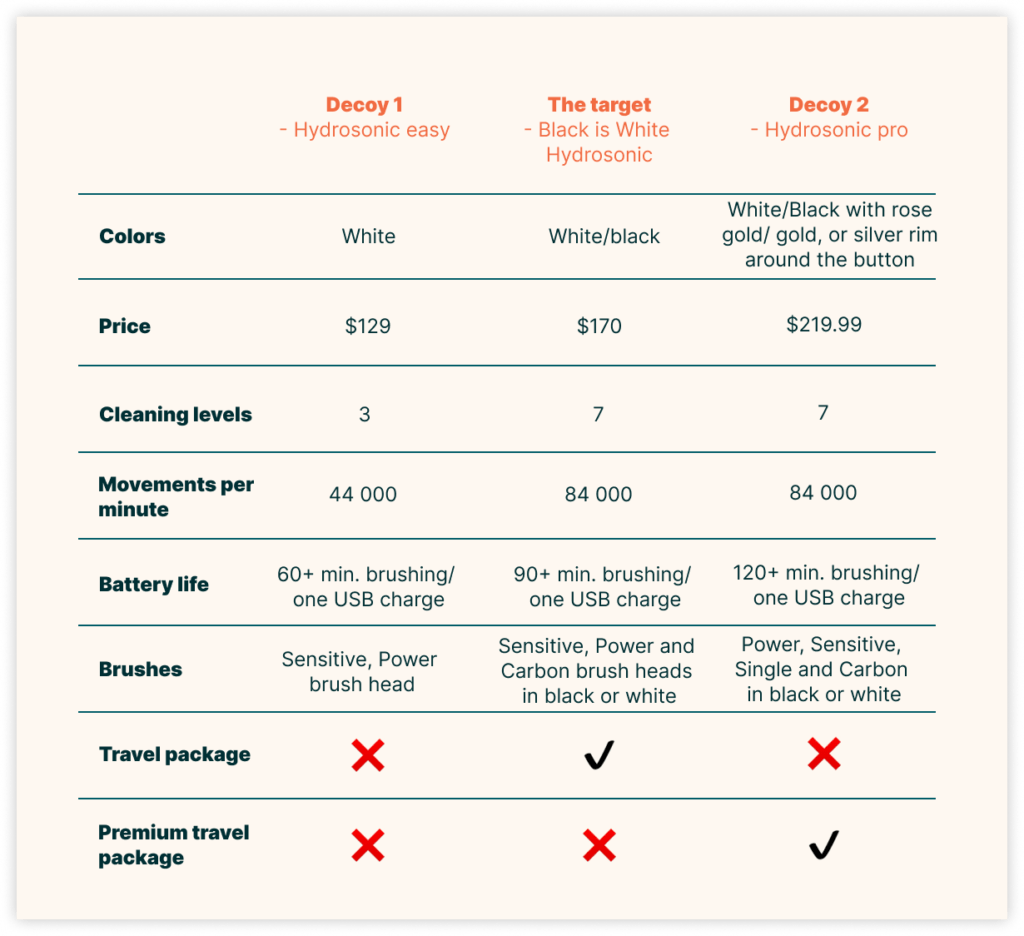
Source: InsideBE
If you make the switch from the target to the Hydrosonic Pro, the most functional parameters remain the same, only the less-profound features are bumped up. Is 30 extra minutes of battery life, an extra brush, and a fancier travel package design worth an additional $50? Most people might find they can do without them.
This solution presumes both brushes (the black and the pro) will have to change dramatically. A less ambitious route is to add just one decoy to an existing product selection.
Option 2. Introduce a single decoy
In this scenario, we would make the Pro brush the target.
Why? Even though it’s currently the most comprehensive option, it doesn’t feel like the most sensible one, because:
- it’s limited to only white;
- it doesn’t feature a carbon brush head, and;
- the mere fact the carbon brush head only comes in black means it would cause a mismatch if you decided to purchase it extra and attach it to the Pro.
The changes we propose in this scenario are less invasive: the core features of the Easy and Pro brushes would remain the same – If there are any diversions, we mark them in italics.
What would change completely is the middle option (the current Black is White), which we would use as a decoy.
If you want to keep the decoy price still favorable (relative to the target) but overall less appealing, you can introduce a new feature.
It would feature carbon brush heads, but have less programs, less brush movements per minute, and less brush heads overall, but would cost nearly as much.
The most fundamental change would be in terms of its color – It would either be white or in an outlandish color that no one would buy, like orange.
Why? Like we said, the beauty of decoys is that they’re subtle; if you go overboard with the price, customers might “catch on” to what you’re doing. So if you want to keep the decoy price still favorable (relative to the target) but overall less appealing, you can introduce a new feature.
This new feature must be something totally irrelevant to the core product features. But at the same time, it must be something that can be used as a justification to the consumer – a strange color, like orange, that nobody wants in the first place might make it less appealing.
Apple used a similar strategy back in 2013 with its “plastic” iPhone 5C (remember those?!)
Some people bought it (not such a perfect decoy after all!), but most people opted for the more expensive 5S. In this setup, paying an extra £80 for the aluminum golden edition compared to the green, plastic one didn’t seem like such a bad idea.
In this case, the product selection could look like this:
Easy: (an option we use to compare the target with): Hydrosonic Easy for $129
- Colors: white
- Cleansing levels: 3
- Movements per minute: 44,000 (currently there is a range between 44,000 – 84,000)
- Battery life: more than 60 minutes of brushing from one USB charge
- Brushes: Power brush head
- No travel package (currently there is a travel package)
Decoy: “White” for $189,99
- Colors: white, orange
- Cleaning levels: 5
- Movements per minute: 84,000
- Battery life: more than 60 minutes of brushing from one USB charge
- Brushes: Power, Carbon brush head
- Travel package
Target: Hydrosonic pro $ 199,99
- Colors: white, black
- Cleaning levels: 7
- Movements per minute: 84 000
- Battery life: more than 60 minutes brushing from one USB charge
- Brushes: Power, Sensitive, Single, and Carbon brush heads (which come both in black and white so there is no color mismatch with the body of the brush).
- Travel package.
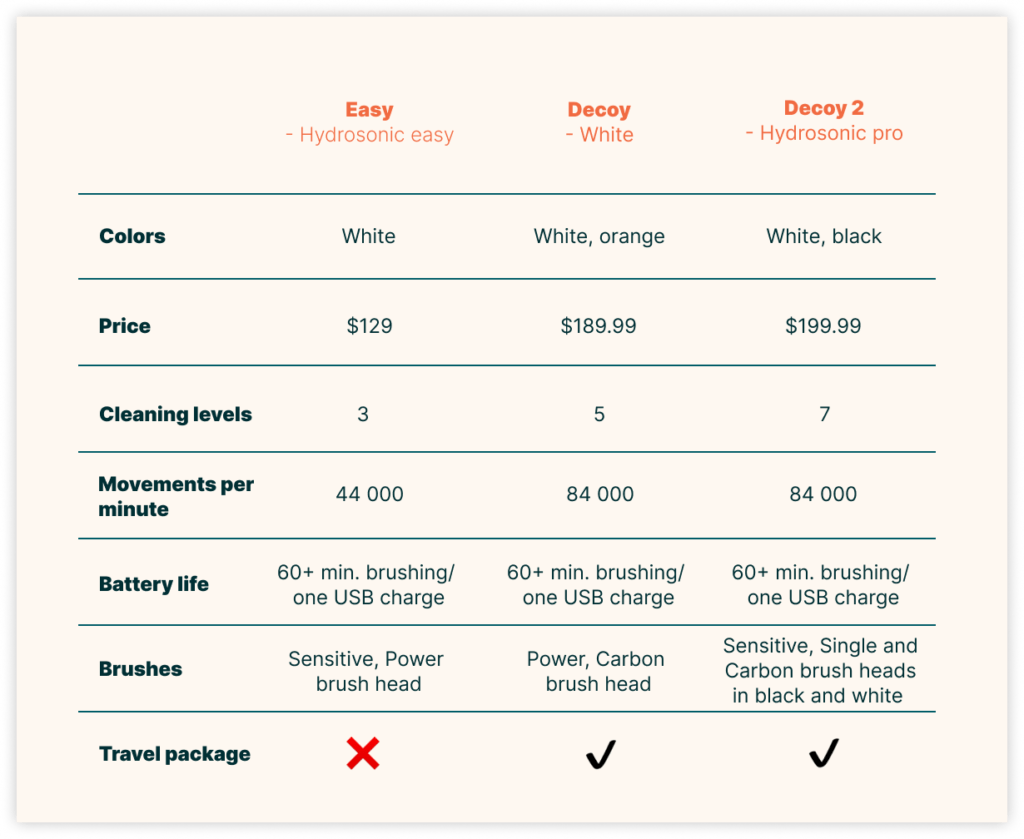
Source: InsideBE
The main changes to the Pro – the fact that it would come in both black and white and includes a color fitting carbon head – would allow Curaprox to say: “The Pro does it all! Professional and gentle, effective whitening. The only brush you’ll ever need!”
Comparing with the decoy provides an easier justification for the choice the customer makes that would otherwise feel unclear and overly complex.
As you can see in both cases, we propose different product changes and vary what product is a decoy and what product is the target.
Yet, what both solutions have in common is that they provide customers with a clear signal of what the sensible option is. Comparing with the decoy provides an easier justification for the choice the customer makes that would otherwise feel unclear and overly complex.
Key Takeaways:
- The Decoy Effect is most likely to work when there are only three options: target, competitor, and decoy. Keep in mind that the target should be something customers already want – just adding a worse alternative to an already bad option might make it seem better – relative to its decoy – but still won’t be enough to open peoples’ hearts and, most importantly, their wallets.
- You can create a basic decoy by offering less of the same stuff (perfume, popcorn, paper towels) for almost the same price.
- If you have a complex product or service, create a one-page overview of all the different alternatives. Make sure these alternatives can be compared across the same parameters. That way, customers can easily compare what the trade-offs of each option are. It should be super easy to see what customers gain by opting for a pricier option and why opting for a decoy (albeit cheaper) wouldn’t make much sense.
- Consider the placement of your target product on the website or on the shelf. Customers have a tendency to go with the middle option (thanks to the middle bias) regardless of the value. The rule of thumb is to display a target in the middle of the array (even if it happens to be the priciest option) instead of creating a price-centered arrangement.

